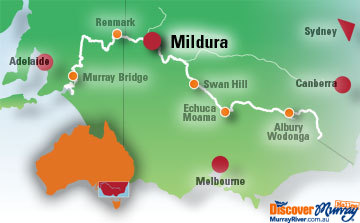
Mildura Riverfront Shared Path - The river and floodplain
Without the river and its floodplain the riverfront reserves would not exist. The river is important to the public, providing recreational and social benefits to the community. Perhaps more importantly the river provides habitat and food resources for a range of freshwater animals including fish, turtles, waterbirds and frogs. In times of drought the river is particularly valuable for other animals including kangaroos, emus and other terrestrial birds.
The floodplain is home to a large number of native plant species including many rare species. It provides vital habitat including breeding and nursery areas for fish, turtles, frogs and waterbirds.
The floodplain and nutrient cycling
Together the river and floodplain act as a nutrient cycling system. In times of flood the floodplain is flushed with waters from upstream, bringing with it nutrients, macro-invertebrates, and small fish. This stimulates the release of nutrients from the floodplain, flushes salts from the surface and begins the cycle
of many wetland plant species.
During times of prolonged drought, when flooding does not occur frequently, nutrient stores including leaf litter & bark, build up in the floodplains. This build up of nutrients in the floodplains can contribute to ‘black water’ events, when flooding finally does occur. ‘Black water’ events occur when the system has a high influx of nutrients creating an environment with a high level of tannins, which causes the water to darken, and a high level of decomposition and microbial activity. This activity removes oxygen from the water, which can result in the death of some sensitive fish species, such as the iconic Murray Cod.
The damp soils that remain in the floodplains when the water recedes stimulate the growth of plants, providing a huge amount of resources and habitat for frogs, waterbirds and other fauna. These processes unfortunately do not occur in a highly regulated system such as the Murray River at the frequency or duration of pre-regulation times. Recent environmental watering events demonstrate that these processes can be re-instated to some degree by pumping water onto the floodplain.
Case Studies
Carp Gudgeon
Identification
Carp Gudgeons are a small laterally compressed fish growing to a maximum of 70mm long, but usually being around 40mm long. They have two distinct top fins which can sometimes have an orange and purple stripe. They have a blunt head profile with subtle varying body colour.
Habitat and Biology
Carp Gudgeons are found in slow-flowing or still back and flood waters. Spawning occurs in shallow water and the eggs are deposited on submerged aquatic vegetation or twigs. The male guards and fans the eggs. Hatching occurs after about 50 hours and newly hatched larvae are 1.8-2.1mm long.
Did you know?
Female Carp Gudgeon may lay up to 2,000 small (0.5mm diameter) eggs
Freshwater Catfish
Identification
The Freshwater Catfish is a medium sized fish growing up to a length of 900mm and weight of 6.8kg, although usually < 500mm and < 2kg. The head is large with four pairs of thick ‘whiskers’ surrounding thick fleshy lips. The skin is smooth, with no scales. The back of adults is usually olive-green to brown and the belly whitish. Juveniles tend to be grey-brown, mottled with darker blotches.
Habitat and Biology
Freshwater catfish prefer slow-flowing streams and lake habitats. Individuals are sexually mature at 3-5 years of age and spawn in spring and summer. The nest is a circular hole constructed from pebbles and gravel. The eggs are large (~3mm) and settle into the pebbles. They take up to seven days to hatch.
This catfish is an opportunistic carnivore and the adult diet consists mainly of shrimps, yabbies, aquatic insects, snails and small fishes. Adults are mostly active at dusk and in the early evening.
Did you know?
The male catfish remains with the nest to fan, clean and guard the eggs.
Mildura Riverfront Shared Path
Published with permission of Mildura Rural City Council
Tell your friends you found this at murrayriver.com.au!
Copyright Discover Murray 2025. This site or any portion of this site must not be reproduced, duplicated, copied, sold, resold, or otherwise exploited for any commercial purpose that is not expressly permitted by DISCOVER MURRAY.






 The Royal Edinburgh Military Tattoo 2023 - Arts On Screen
The Royal Edinburgh Military Tattoo 2023 - Arts On Screen CREEDENCE CLEARWATER COLLECTIVE
CREEDENCE CLEARWATER COLLECTIVE Angove Family Winemakers Art Exhibition featuring Wendy Neal
Angove Family Winemakers Art Exhibition featuring Wendy Neal

